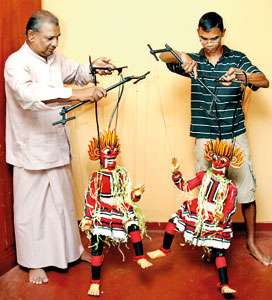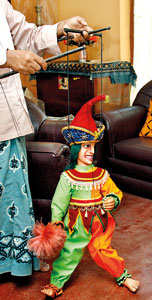In Ambalangoda, the southern hub of traditional art, the
puppet master Premin is well known. Premin’s father and
grandfather were both famous
puppeteers and his son is a
fourth-generation puppeteer.
His four-year-old granddaughter is now on her way to becoming the next artiste of the family!
Sadly though, Premin’s son Indika does not practice puppetry fulltime, and it is very unlikely that his granddaughter will ever give the art more time than any of us give our hobbies and our pets. This is the one thing that Premin regrets about his life, and wants to change in his world.
He loves to share stories of his childhood travelling with his father Jemis, performing puppet-shows at carnivals. He has seen many
legendary puppeteers, and believes that puppetry is one of the most
powerful forms of traditional art. It is amazing to hear the story of Jemis performing the Ehelepola play in Kurunegala.
The audience was so moved that even though it was just a wooden doll, some people had begun to sob as Veera Madduma Bandara’s head was severed.
“That is the power of the puppet!”
Despite his love for puppetry, Premin won’t force his children to take it up as a career. “Times have changed, and we have to fill this,” he says, pointing to his belly. “Nowadays people don’t appreciate traditional art, they want foreign things”.
As he says, puppetry and other traditional art forms like naadagam and kolam are a fun and effective way of learning history.
“If people took an interest, we could perform the tales of Sri Lankan
history for a very small price.” That way, we could have fun learning and the artists would earn some money to improve their puppets and
stage-craft.
Sri Lankan puppetry was in fact at a very high standard once upon a time, Premin says. In 1870, Premin’s grandfather Ganwari Podi Sirina Guru performed the Ehelepola play for the Duke of Edinburgh when he visited
Sri Lanka.
He was so pleased that Podi Sirina was rewarded with a gift of a gold medal and five hundred rupees – you might have bought five cars with so much money at that time! The 47 puppets that made up the cast that day were later sold to a German art collector, and are now kept in a museum in West Germany. The small marionette (puppet on strings) was popular in Europe at the time, but apparently our
puppets caused a stir when they were exhibited – they were life size!
Although contemporary
Sri Lankan puppet artists don’t use such large dolls, the method for
creating them is unchanged.
The puppet-maker first
fashions the different parts of the puppet’s body, separately, using wood from the goda kaduru tree. Then he paints them using valichchi or dorana thel. Valichchi is made of powered natural ingredients, while dorana thel is extracted by setting fire to the centre of the massive dorana tree.
Although the kind of paint used on a puppet is not important, the colour sure is. Pink characters are feminine while characters with bold patterned faces are magical or
heroic.
The colour of the wig (made of real human hair!) tells age. Once the painting and wigs have been
completed, the puppet-maker joints the doll together and begins
costuming. “They’re just like actors,” Premin laughs, “because each has many different costumes”.
While some costumes are like
regular clothes, others are quite
extravagant. Royal characters, for example, wear orange, black or blue velvet lined with cotton and adorned with pearls, beads and sequins in multi-colours.
The puppet-stage is a large metal structure of two sections. The front is where the puppets are seen to be ‘acting’, and the back, where the puppet-masters stand and hold the strings of the marionettes. There is a special railing between the front and back sections of the stage, on which the puppet-masters lean in order to support the combined weight of their bodies and the
puppets’.
As with many other “arty” and “creative” careers, puppetry is not as easy as it looks. But because we as an audience are ignorant of the importance and difficulty of the art, the masters are not appreciated enough, and their craft is dying out. What would YOU do to help?
|



